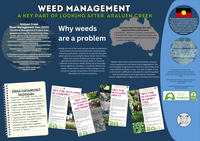Display Boards - Weed Management
Management of weeds is important for Araluen Creek because of the impact of weeds on the natural environment and on agricultural production. Current major weeds in the area are African Boxthorn, Broad-leaved Privet, Small-leaved Privet, Blackberry and Madeira Vine. Weeds are being tackled by Research, Prevention, Physical removal, Chemicals, ongoing vigilance and a holistic approach with custodians, landowners, government agencies working together.
Araluen Creek Weed Management Plan (2021)
The Weed Management Project area assessment had 91 monitoring sites.
The most significant woody weed species identified were:
- African Boxthorn (Lycium ferocissimum) a Weed of National Significance, recorded in 64 sections;
- Broad-leaved Privet (Ligustrum lucidum) an Environmental Weed, in 71 of the survey sections;
- Small-leaved Privet (Ligustrum sinense) an Environmental Weed, was in 60 sections (also see useful tips for management as for broad-leaved privet);
- Blackberry (Rubus fruticosus species aggregata) a Weed of National Significance, in 19 sections.
In 2023, Madeira Vine (Anredera cordifolia) was identified as a weed threat in the valley possibly emerging because there were fewer frosts to suppress its growth.
Upper Deua Catchment Landcare Group manages regular weed control projects.
See NSW Weedwise for more information on these and other weeds.
Why weeds are a problem
Weeds are one of the most serious threats to Australia's environment and primary production resource base. Nationally pest plants continue to invade the land with exotic species accounting for about 15 per cent of flora. About one-quarter of them are either serious agricultural and environmental weeds or have the potential to be serious weeds. Almost all of Australia's native vegetation has been, or could be, affected by weeds. Those effects could include changes to the structure, species composition, fire frequency and abundance of native ecosystems.
Weeds reduce farm and forest productivity, displace native species and contribute to land degradation. The cost of weeds to agricultural industries is estimated to be many billions of dollars a year. The cost of weeds to the environment is difficult to calculate but could be greater than the estimated cost to agricultural industries.
Source: Department of Agriculture, Fisheries and Forestry
Australian Weed Strategy 2017-2027
The Australian Government, Department of Agriculture and Water Resources collated and edited the publication of the Australian Weed Strategy 2017-2027 for the Invasive Plants and Animals Committee.
The foundations for national level weed management were established in 1997 with the National Weeds Strategy, which was revised in 2007 to become the Australian Weeds Strategy.
The strategy outlines the principles for weed management in Australia and provides national guidance on best practice weed management. The focus is on preventing the establishment of and managing existing exotic weeds. Native plants as weeds
are mostly left to state and territory legislation.
Goal 1. Prevention, detection and early intervention
Priorities:
1.1 commit to and continuously strengthen effective risk-based approaches to pre-border and border activities
1.2 adopt consistent risk assessment and prioritisation approaches within Australia
1.3 develop and implement early detection, diagnostics and monitoring
systems for priority weed species.
Goal 2. Minimise the impact of established weeds
Priorities:
2.1 develop and improve national approaches to coordinate, invest and manage the impacts of weeds on values and assets
2.2 increase participation in coordinated management approaches across all land tenures
2.3 improve national approach, capacity and commitment to weed
containment
2.4 enhance weed control techniques and integrate management options.
Goal 3. Enhance Australia’s capacity and commitment to weed management
Priorities:
3.1 develop the knowledge, capacity and commitment of key stakeholders to play an active and constructive role in weed management
3.2 maintain and enhance long-term research, development and extension capacity and capability
3.3 develop and apply national data, information and knowledge
infrastructure to support effective weed management
3.4 improve institutional arrangements and decision support resources to increase the effectiveness of weed management.
Weed management techniques
- Research - the weeds, the area, what really works and what really doesn’t;
- Prevention - reduce habitat suitable for weeds, maintain existing native plants;
- Physical removal - by hand or machine, follow up to remove new seedlings;
- Chemicals - used selectively in conjunction with other approaches
- Ongoing vigilance - especially as changing climate favours new weed species;
- Holistic approach - custodians, landowners, government agencies working
together. Weeds don’t respect borders or fences.





